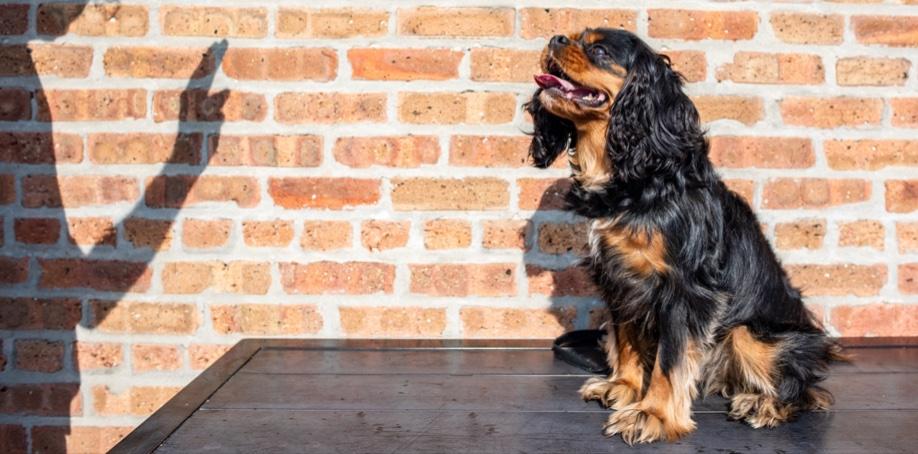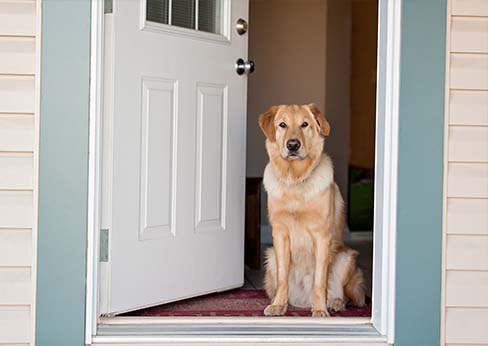
Now that your dog has learned to stay on-command, you can start to incorporate stay into some of your daily activities. Since “stay” can be used in a variety of settings, it is important to practice regularly with your dog so that they understand they may be asked to stay at any time.
Although many of these ideas will seem like games to your dog, you are reinforcing the notion that your dog needs to wait for your release command for them to begin their fun. Consider these practice sessions when you want to strengthen your dog’s ability to stay.
Hide and Seek
The rules of hide-and-seek for dogs are similar to those for humans. Although your dog may not understand specifics such as waiting for you to count to ten or check for people hidden in laundry baskets deep in the closet, a dog will search for whatever you want them to find.
- Pick something to hide. It can be a toy, a treat, or a person. To hold your dog’s attention longer, choose something which your dog loves (such as their favorite toy).
- Have your dog in a sit-stay. You want your dog to be relaxed in a position that they can’t immediately run to the item. If your dog is more comfortable, you can have your dog in a down position instead of a sit.
- Go hide the item in another room. Make sure you place the item in a location where your dog can easily find it. Remember that your dog will be using their nose to search, so the item needs to be distinguishable from other things in the surrounding area. Finally, make sure your dog does not cheat by following you!
4. Release your dog. Always use their release word like “All Done” or “Okay” but keep the release command consistent from training. When your dog is first starting, you might have to give them clues to help them understand what you want them to do.
Hide and seek is a fun game for dogs because they love the mental stimulation and physical exercise that comes from running around looking for hidden items. Be sure to use verbal praise when they find whatever you hid – your dog will be more likely to maintain their interest in playing if they feel like their efforts are validated.
Fetch
Fetch – the kingpin of human-dog games. Dogs love to run for objects thrown in the distance by their owner (or whoever will entertain them). Since dogs will instinctually run after objects, you can use the game to curb your dog’s impulse to immediately chase. This makes fetch the ultimate test for a stay.
- Get your dog in a stay and pretend to throw the toy or the ball. Your dog’s stay position, whether it be a sit, down, or standing stay, does not matter as long as they can remain still. Pretending to throw the toy or ball makes your dog aware that they need to be patient and not immediately chase after whatever is in your hand. Especially in the beginning, you might have to hold on to the collar to make sure they do not run off after it. Keep repeating this step until your dog can stay.
2. Throw the toy. Once again hold their collar to keep your dog from running after it. They should see where the object lands so that they know where to run. You may need to repeat the stay or wait for a command to redirect your dog’s attention from the toy to you.
3. Give the release command. Your dog’s reward is the release to run after the toy.
When playing fetch, your dog wants that ball. They need that ball. But if your dog can master their stay, then they will be patient and wait until you give them permission to go chase whatever you threw.
Stay During Distractions
As your dog becomes more consistent with their stays, it can be fun to start adding distractions to test your dog’s focus. Here are some ideas:- You can “accidentally” drop treats in front of your dog or squeak a toy. Do they have the impulse control to hold the stay? Or will they lose focus and react to the stimuli in front of them?
- You can bounce a ball or tease him with a toy. Toys are recreational and fun, but can you do remain focused on the task-at-hand?
- You can have your dog in a stay during tug-of-war. The nature of the game is to take the rope or toy from the other person. Does your dog have the willpower to resist pulling? (The reward for staying is that they get to tug on the toy when you give the release command.)
Waiting as Their Feet are Wiped After Being Outside
Although not a game, you can use the stay command to teach your dog to let you wipe their feet when they come inside the house. This is especially useful if you live in rainy environments or have a lawn with dirt. Give the stay command as you pick up your dog’s paws one-by-one and wipe them with a towel or cloth. Your dog can move around as you wipe their feet, but they should remain in the same place until you give the release command.
Conclusion
The stay command can be used for so many useful things in your dog’s daily life. As one of the basic commands, “stay” or “wait” should be taught early in your dog’s training so that it may be expanded on and generalized in a variety of environments. With these advanced uses, remember to keep training light and fun. Good luck!





